A Comparison of Sporadic-E Occurrence Rates Using GPS Radio Occultation and Ionosonde Measurements
Abstract
:1. Introduction
2. Methods
2.1. Arras Method
2.2. Niu Method
2.3. Chu Method
2.4. Yu Method
2.5. Gooch Method
2.6. Ionosonde Measurements
2.7. Comparison Criteria
3. Results
3.1. No Lower fbEs Limit
3.2. fbEs MHz
4. Conclusions
Author Contributions
Funding
Data Availability Statement
Acknowledgments
Conflicts of Interest
References
- Whitehead, J. Recent work on mid-latitude and equatorial sporadic-E. J. Atmos. Terr. Phys. 1989, 51, 401–424. [Google Scholar] [CrossRef]
- Rice, D.; Sojka, J.; Eccles, J.; Raitt, J.; Brady, J.; Hunsucker, R. First results of mapping sporadic E with a passive observing network. Space Weather 2011, 9. [Google Scholar] [CrossRef]
- Fabrizio, G.A. High Frequency Over-the-Horizon Radar: Fundamental Principles, Signal Processing, and Practical Applications; McGraw-Hill Education: New York, NY, USA, 2013. [Google Scholar]
- Haldoupis, C. A tutorial review on sporadic E layers. In Aeronomy of the Earth’s Atmosphere and Ionosphere; Springer: Berlin/Heidelberg, Germany, 2011; pp. 381–394. [Google Scholar]
- Mathews, J. Sporadic E: Current views and recent progress. J. Atmos. Sol.-Terr. Phys. 1998, 60, 413–435. [Google Scholar] [CrossRef]
- Smith, E.K. Worldwide Occurrence of Sporadic E.; US Department of Commerce, National Bureau of Standards: Boulder, CO, USA, 1957; Volume 582. [Google Scholar]
- Matsushita, S.; Reddy, C. A study of blanketing sporadic E at middle latitudes. J. Geophys. Res. 1967, 72, 2903–2916. [Google Scholar] [CrossRef]
- Whitehead, J. The structure of sporadic E from a radio experiment. Radio Sci. 1972, 7, 355–358. [Google Scholar] [CrossRef]
- Pignalberi, A.; Pezzopane, M.; Zuccheretti, E. A spectral study of the mid-latitude sporadic E layer characteristic oscillations comparable to those of the tidal and the planetary waves. J. Atmos. Sol.-Terr. Phys. 2015, 122, 34–44. [Google Scholar] [CrossRef]
- Yadav, V.; Kakad, B.; Bhattacharyya, A.; Pant, T. Quiet and disturbed time characteristics of blanketing Es (Esb) during solar cycle 23. J. Geophys. Res. Space Phys. 2017, 122, 11–591. [Google Scholar] [CrossRef]
- Hocke, K.; Igarashi, K.; Nakamura, M.; Wilkinson, P.; Wu, J.; Pavelyev, A.; Wickert, J. Global sounding of sporadic E layers by the GPS/MET radio occultation experiment. J. Atmos. Sol.-Terr. Phys. 2001, 63, 1973–1980. [Google Scholar] [CrossRef]
- Wu, D.L.; Ao, C.O.; Hajj, G.A.; de La Torre Juarez, M.; Mannucci, A.J. Sporadic E morphology from GPS-CHAMP radio occultation. J. Geophys. Res. Space Phys. 2005, 110. [Google Scholar] [CrossRef] [Green Version]
- Reinisch, B.W.; Galkin, I.A. Global ionospheric radio observatory (GIRO). Earth Planets Space 2011, 63, 377–381. [Google Scholar] [CrossRef] [Green Version]
- Merriman, D.; Nava, O.; Dao, E.; Emmons, D. Comparison of seasonal foEs and fbEs occurrence rates derived from global Digisonde measurements. Atmosphere 2021, 12, 1558. [Google Scholar] [CrossRef]
- Sharing Earth Observation Resources. FormoSat-3/COSMIC (Constellation Observing System for Meteorology, Ionosphere and Climate). 2014. Available online: https://directory.eoportal.org/web/eoportal/satellite-missions/content/-/article/formosat-3 (accessed on 6 January 2021).
- Rocken, C.; Ying-Hwa, K.; Schreiner, W.S.; Hunt, D.; Sokolovskiy, S.; McCormick, C. COSMIC system description. Terr. Atmos. Ocean. Sci. 2000, 11, 21–52. [Google Scholar] [CrossRef] [Green Version]
- Satellite, N.E.; Service, D. COSMIC 2. 2020. Available online: https://www.nesdis.noaa.gov/COSMIC-2 (accessed on 6 January 2021).
- Ware, R.H.; Fulker, D.W.; Stein, S.A.; Anderson, D.N.; Avery, S.K.; Clark, R.D.; Droegemeier, K.K.; Kuettner, J.P.; Minster, J.B.; Sorooshian, S. SuomiNet: A real-time national GPS network for atmospheric research and education. Bull. Am. Meteorol. Soc. 2000, 81, 677–694. [Google Scholar] [CrossRef] [Green Version]
- Zeng, Z.; Sokolovskiy, S. Effect of Sporadic E Clouds on GPS Radio Occultation Signals. Geophys. Res. Lett. 2010, 37. [Google Scholar] [CrossRef]
- Chu, Y.H.; Su, C.L.; Ko, H.T. A global survey of COSMIC ionospheric peak electron density and its height: A comparison with ground-based ionosonde measurements. Adv. Space Res. 2010, 46, 431–439. [Google Scholar] [CrossRef]
- Kursinski, E.R.; Hajj, G.A.; Leroy, S.S.; Herman, B. The GPS radio occulation technique. TAO Terr. Atmos. Ocean. Sci. 2000, 11, 53–114. [Google Scholar] [CrossRef] [Green Version]
- Chu, Y.H.; Wang, C.; Wu, K.; Chen, K.; Tzeng, K.; Su, C.L.; Feng, W.; Plane, J. Morphology of sporadic E layer retrieved from COSMIC GPS radio occultation measurements: Wind shear theory examination. J. Geophys. Res. Space Phys. 2014, 119, 2117–2136. [Google Scholar] [CrossRef]
- Arras, C.; Wickert, J. Estimation of ionospheric sporadic E intensities from GPS radio occultation measurements. J. Atmos. Sol.-Terr. Phys. 2018, 171, 60–63. [Google Scholar] [CrossRef]
- Yu, B.; Scott, C.J.; Xue, X.; Yue, X.; Dou, X. Derivation of global ionospheric Sporadic E critical frequency (fo Es) data from the amplitude variations in GPS/GNSS radio occultations. R. Soc. Open Sci. 2020, 7, 200320. [Google Scholar] [CrossRef] [PubMed]
- Niu, J.; Weng, L.; Meng, X.; Fang, H. Morphology of Ionospheric Sporadic E Layer Intensity Based on COSMIC Occultation Data in the Midlatitude and Low-Latitude Regions. J. Geophys. Res. Space Phys. 2019, 124, 4796–4808. [Google Scholar] [CrossRef]
- Gooch, J.Y.; Colman, J.J.; Nava, O.A.; Emmons, D.J. Global ionosonde and GPS radio occultation sporadic-E intensity and height comparison. J. Atmos. Sol.-Terr. Phys. 2020, 199, 105200. [Google Scholar] [CrossRef]
- Reddy, C.; Mukunda Rao, M. On the physical significance of the Es parameters ƒbEs, ƒEs, and ƒoEs. J. Geophys. Res. 1968, 73, 215–224. [Google Scholar] [CrossRef]
- Savitzky, A.; Golay, M.J. Smoothing and differentiation of data by simplified least squares procedures. Anal. Chem. 1964, 36, 1627–1639. [Google Scholar] [CrossRef]
- Haldoupis, C. An Improved Ionosonde-Based Parameter to Assess Sporadic E Layer Intensities: A Simple Idea and an Algorithm. J. Geophys. Res. Space Phys. 2019, 124, 2127–2134. [Google Scholar] [CrossRef]
- Syndergaard, S. COSMIC S4 Data; UCAR/CDAAC: Boulder, CO, USA, 2006. [Google Scholar]
- Ahmad, B. Accuracy and Resolution of Atmospheric Profiles Obtained from Radio Occultation Measurements. Ph.D. Thesis, Stanford University, Stanford, CA, USA, 1999; p. 1647. [Google Scholar]
- Galkin, I.A.; Reinisch, B.W. The new ARTIST 5 for all digisondes. Ionosonde Netw. Advis. Group Bull. 2008, 69, 1–8. [Google Scholar]
- Cathey, E.H. Some midlatitude sporadic-E results from the Explorer 20 satellite. J. Geophys. Res. 1969, 74, 2240–2247. [Google Scholar] [CrossRef]
- Yang, K.F.; Chu, Y.H.; Su, C.L.; Ko, H.T.; Wang, C.Y. An examination of FORMOSAT-3/COSMIC ionospheric electron density profile: Data quality criteria and comparisons with the IRI model. Terr. Atmos. Ocean. Sci. 2009, 20, 193. [Google Scholar] [CrossRef] [Green Version]
- Gareth, J.; Daniela, W.; Trevor, H.; Robert, T. An Introduction to Statistical Learning: With Applications in R; Spinger: Berlin/Heidelberg, Germany, 2013. [Google Scholar]
- Baggaley, W. Structure in the seasonal variations of Es at southern latitudes. J. Atmos. Terr. Phys. 1986, 48, 385–391. [Google Scholar] [CrossRef]
- Pietrella, M.; Bianchi, C. Occurrence of sporadic-E layer over the ionospheric station of Rome: Analysis of data for thirty-two years. Adv. Space Res. 2009, 44, 72–81. [Google Scholar] [CrossRef]
- Haldoupis, C.; Pancheva, D.; Singer, W.; Meek, C.; MacDougall, J. An explanation for the seasonal dependence of midlatitude sporadic E layers. J. Geophys. Res. Space Phys. 2007, 112. [Google Scholar] [CrossRef]
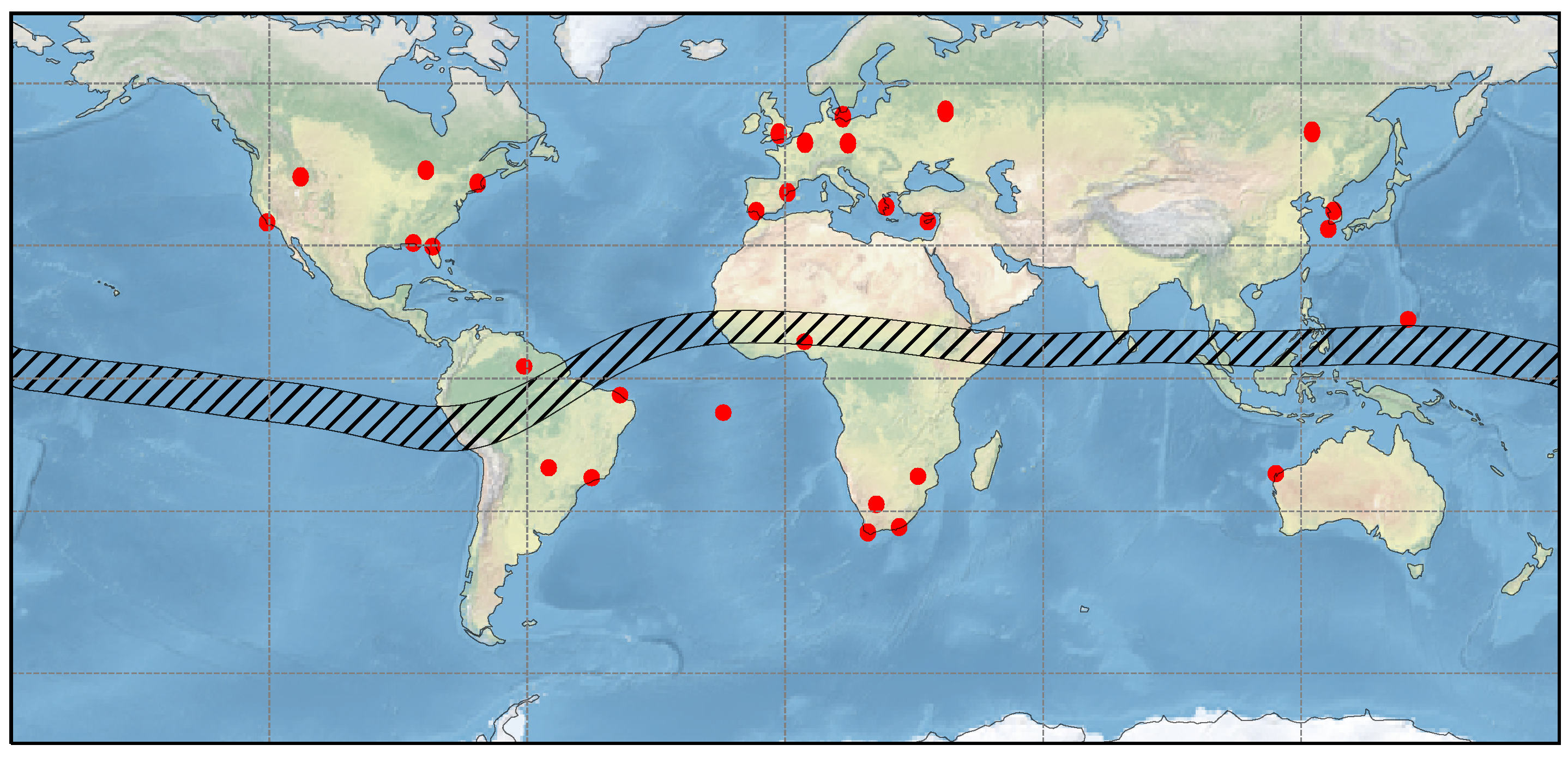
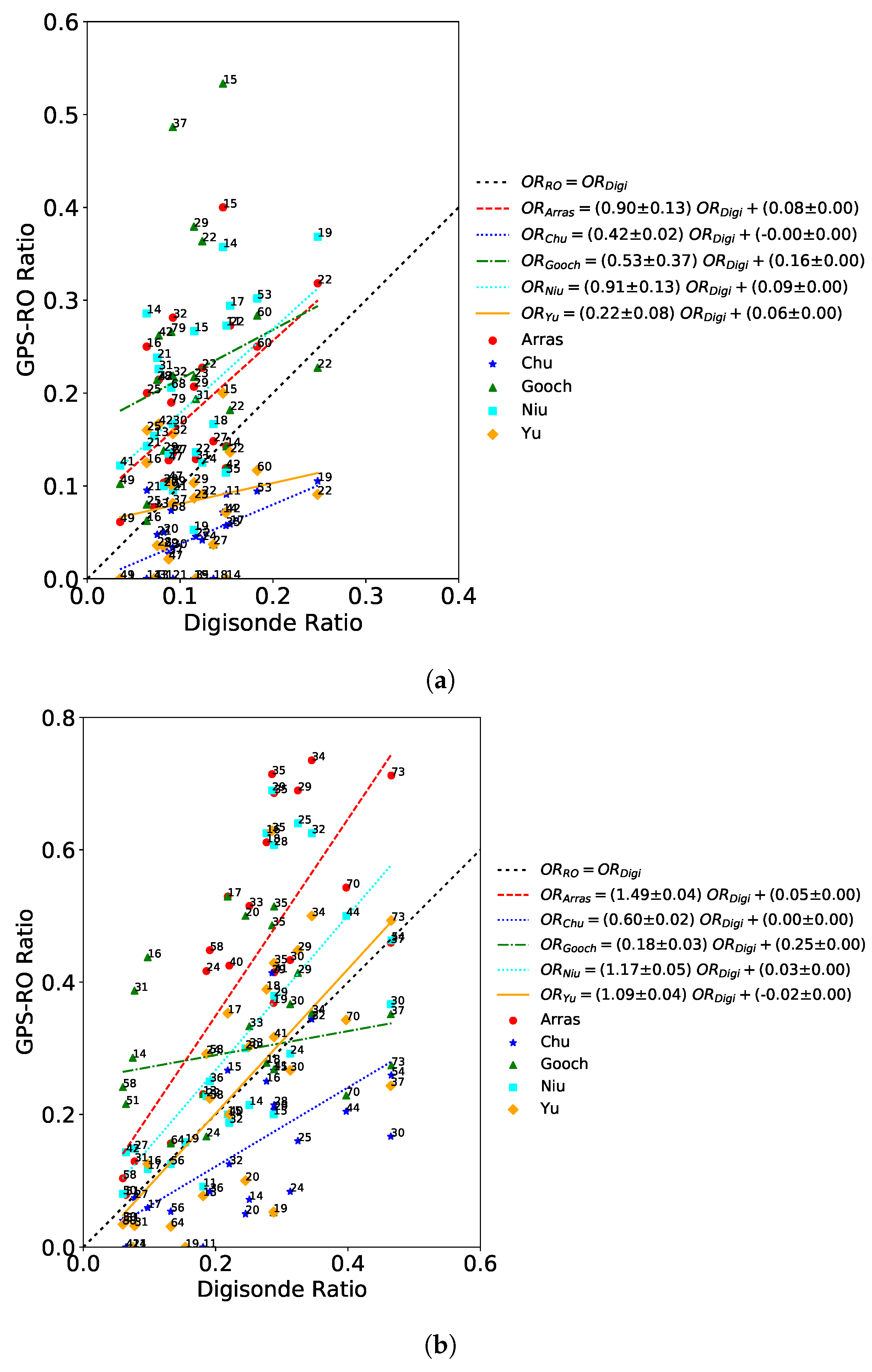
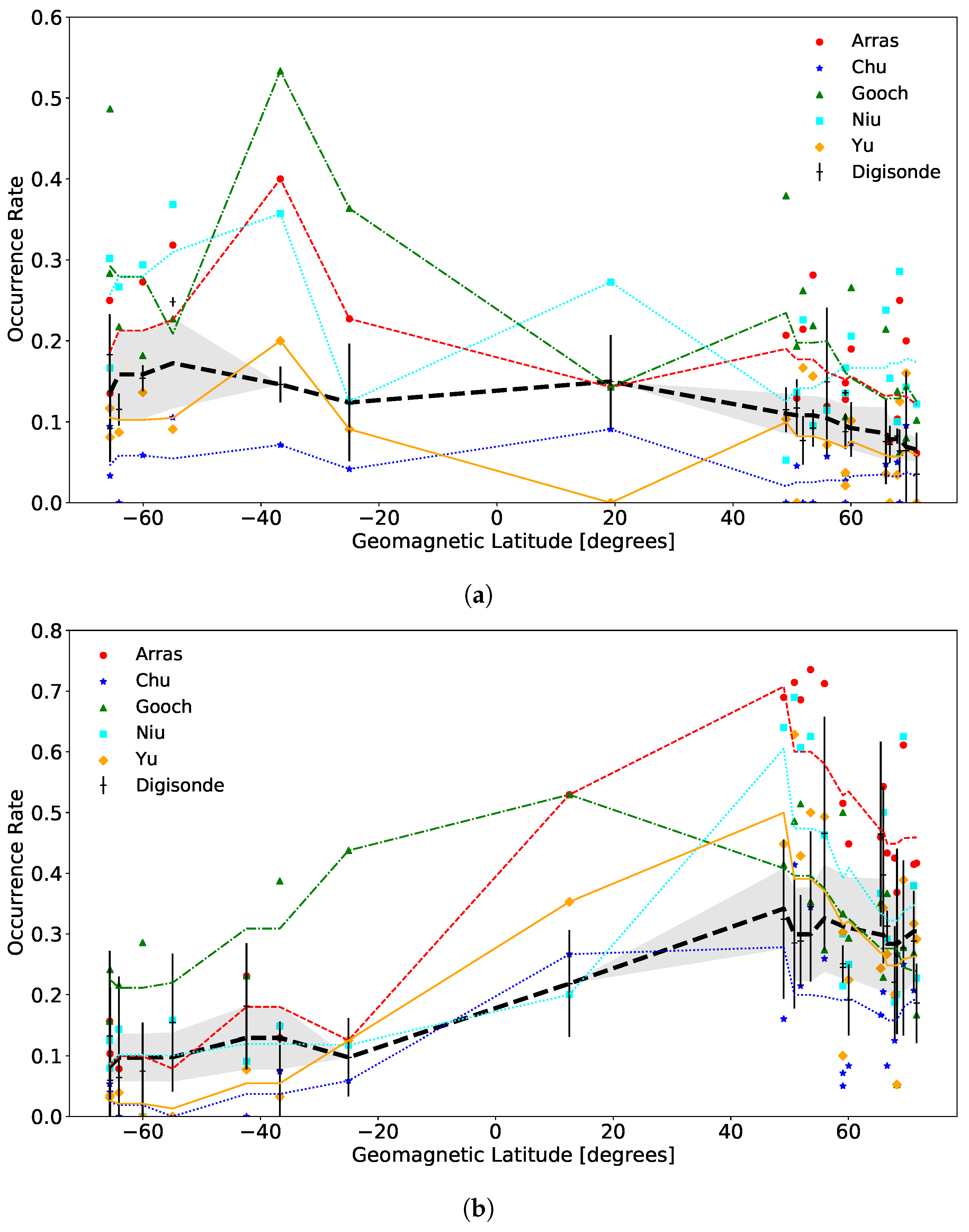
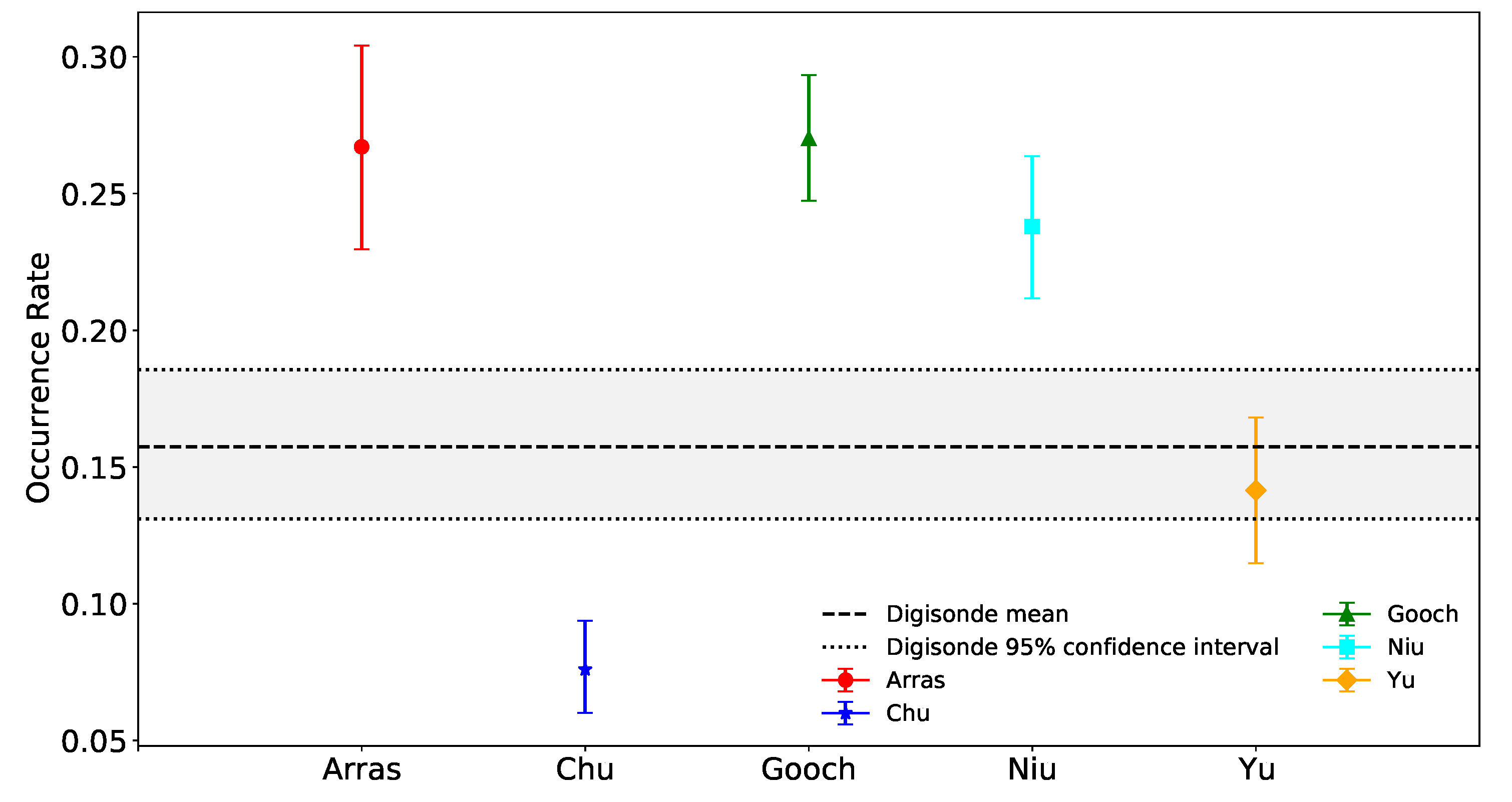
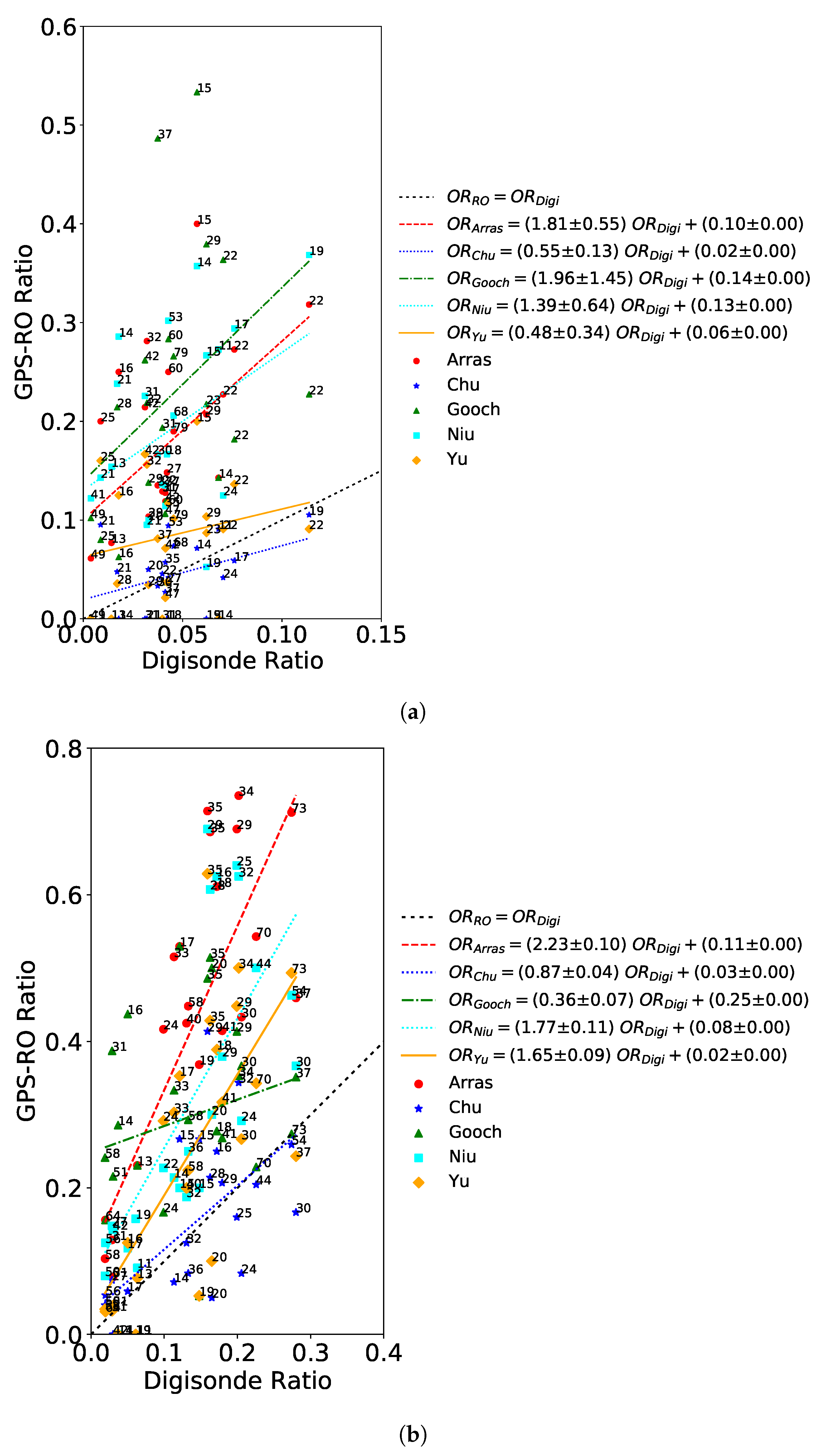
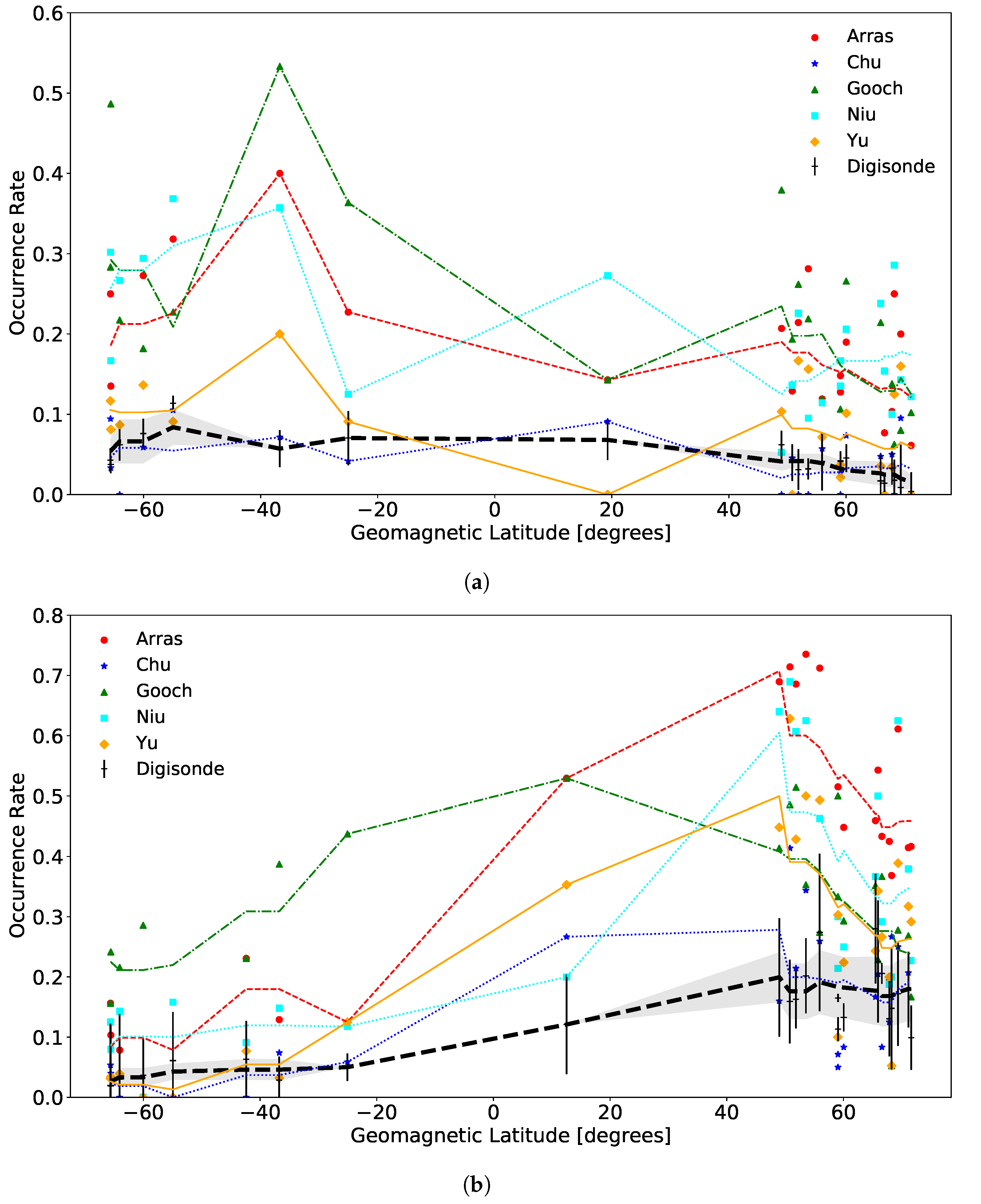

| Technique | Criteria |
|---|---|
| Arras | SNR standard deviation greater than 0.2 |
| Niu | Maximum TEC perturbation gradient () greater than 0.12 TECU/km |
| Chu | (1) and phase perturbation greater than 5 cm |
| (2) Ratio of and within | |
| (3) Amplitude of normalized SNR perturbation greater than 0.01 | |
| Yu | Maximum greater than 0.66 |
| Gooch | fbEs calculated from TEC perturbation and 170 km effective |
| sporadic-E length greater than 3 MHz |
| Technique | Average Number of Observations | Average Number of Observations | Ratio |
|---|---|---|---|
| Ionosonde | 249,524 | — | — |
| (1) no fbEs limit | — | 39,485 | 0.16 |
| (2) fbEs MHz | — | 19,546 | 0.08 |
| Arras | 156 | 42 | 0.27 |
| Gooch | 156 | 42 | 0.27 |
| Yu | 156 | 22 | 0.14 |
| Chu | 118 | 9 | 0.08 |
| Niu | 118 | 28 | 0.24 |
| Technique | Dec.–Feb. | Mar.–May | Jun.–Aug. | Sep.–Nov. | Entire Year |
|---|---|---|---|---|---|
| Arras | 0.01 | 0.00 | 0.12 | 0.03 | 0.00 |
| Chu | 0.00 | 0.00 | 0.02 | 0.04 | 0.00 |
| Gooch | 0.00 | 0.00 | 0.85 | 0.00 | 0.00 |
| Niu | 0.00 | 0.00 | 0.68 | 0.01 | 0.00 |
| Yu | 0.29 | 0.57 | 0.67 | 0.21 | 0.57 |
| Technique | Dec.–Feb. | Mar.–May | Jun.–Aug. | Sep.–Nov. | Entire Year |
|---|---|---|---|---|---|
| Arras | 0.00 | 0.00 | 0.00 | 0.00 | 0.00 |
| Chu | 0.69 | 0.37 | 0.75 | 0.90 | 0.88 |
| Gooch | 0.00 | 0.00 | 0.00 | 0.00 | 0.00 |
| Niu | 0.00 | 0.00 | 0.01 | 0.00 | 0.00 |
| Yu | 0.01 | 0.08 | 0.15 | 0.08 | 0.00 |
Publisher’s Note: MDPI stays neutral with regard to jurisdictional claims in published maps and institutional affiliations. |
© 2022 by the authors. Licensee MDPI, Basel, Switzerland. This article is an open access article distributed under the terms and conditions of the Creative Commons Attribution (CC BY) license (https://creativecommons.org/licenses/by/4.0/).
Share and Cite
Carmona, R.A.; Nava, O.A.; Dao, E.V.; Emmons, D.J. A Comparison of Sporadic-E Occurrence Rates Using GPS Radio Occultation and Ionosonde Measurements. Remote Sens. 2022, 14, 581. https://doi.org/10.3390/rs14030581
Carmona RA, Nava OA, Dao EV, Emmons DJ. A Comparison of Sporadic-E Occurrence Rates Using GPS Radio Occultation and Ionosonde Measurements. Remote Sensing. 2022; 14(3):581. https://doi.org/10.3390/rs14030581
Chicago/Turabian StyleCarmona, Rodney A., Omar A. Nava, Eugene V. Dao, and Daniel J. Emmons. 2022. "A Comparison of Sporadic-E Occurrence Rates Using GPS Radio Occultation and Ionosonde Measurements" Remote Sensing 14, no. 3: 581. https://doi.org/10.3390/rs14030581
APA StyleCarmona, R. A., Nava, O. A., Dao, E. V., & Emmons, D. J. (2022). A Comparison of Sporadic-E Occurrence Rates Using GPS Radio Occultation and Ionosonde Measurements. Remote Sensing, 14(3), 581. https://doi.org/10.3390/rs14030581






